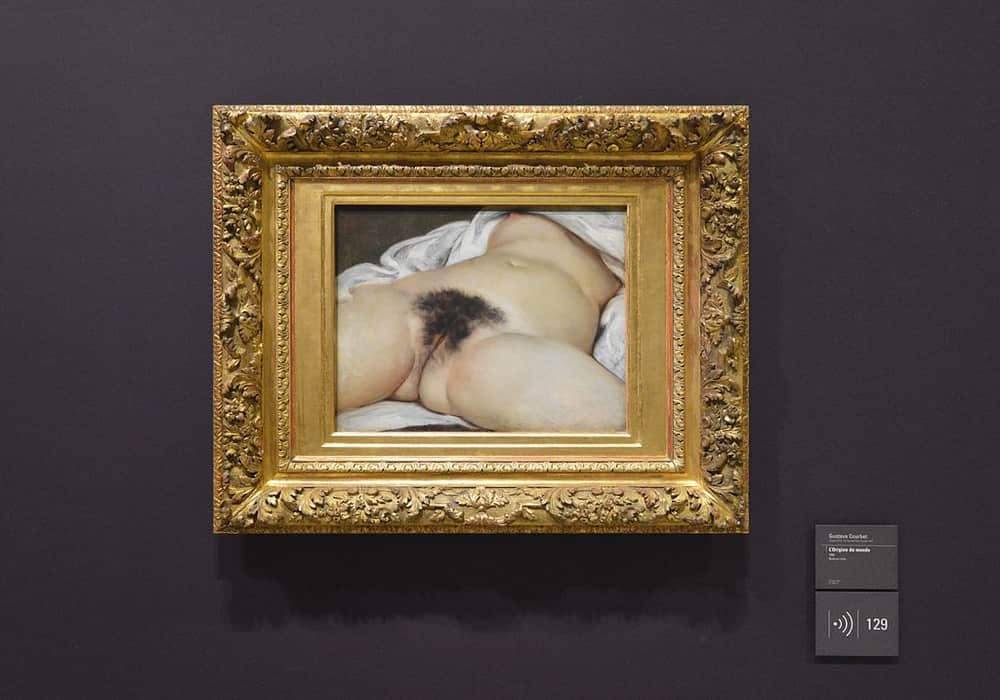Painting The Origin of the world, From Fantasies to Unveiling
Painting The Origin of the world “L’Origine du monde“, painted by Gustave Courbet represents the vulva and the torso of a woman lying naked on a bed, her thighs apart, and framed so that nothing can be seen above the breasts (partly covered with a sheet) or below the breasts. thighs.
Courbet never stopped revisiting the female nudity, sometimes in a frankly libertine vein. But with L’Origine du monde, he allows himself a daring and frankness that give the painting its power of fascination.
The quasi-anatomical description of a female sex is not attenuated by any historical or literary artifice. Thanks to Courbet’s great virtuosity and the refinement of an amber colored range, L’Origine du monde escapes pornographic status.
The frankness and the audacity of this new language do not exclude a link with the tradition: thus, the ample and sensual touch and the use of the color recalls the Venetian painting, and Courbet himself claimed to be Titian and Veronese. , Correggio, and the tradition of carnal and lyrical painting.
The Origin of the World, now presented without any cover, finds its rightful place in the history of modern painting. But he never ceases to pose the question of gaze in a disturbing way.
Description
Although the work was not exhibited in public until the end of the twentieth century, it is known and described by commentators in the artistic and literary world of its time, and in the first place by Maxime Du Camp who sees it, around 1867, at its first owner and presents it in these terms:
“In the toilet of the foreign character, we saw a small painting hidden under a green veil. When the veil was removed, one remained amazed to see a woman of life size, seen from the front, moved and convulsed, remarkably painted, reproduced con amore, as the Italians say, and giving the last word to realism. But, by an inconceivable oversight, the craftsman who had copied his model from nature, had neglected to represent the feet, legs, thighs, stomach, hips, chest, hands, arms, shoulders , neck and head. ”
L’Origine du monde is a painting of female nudes produced by Gustave Courbet in 1866. It is an oil on canvas 46 × 55 cm, exhibited at the Musée d’Orsay since 1995.
“The Origin of the World”: end of the dispute between Facebook and a user who accused him of censorship
Frédéric Durand, a school teacher, criticized the social network for having deactivated his personal account, opened under the pseudonym Fred La Face De Fredb, “without notice or proof”, February 27, 2011. The cut would have occurred a few hours after the publication on his wall of Courbet’s famous painting, L’Origine du monde, which represents a female sex.
Facebook’s policy on nudity has long been contested. While its Community Standards state that it will “allow photographs of paintings sculptures and other art that depicts nude figures”, the social media giant has often been accused of taking down realistic artworks that depict nudity.
But in March 2018, the court dismissed Frédéric Durand, ruling that it had not been shown “that the deactivation of the Fred La Face de Fredb account would be due to the posting on the wall of a photo of Gustave Courbet’s painting The origin of the world.
Discreet owners
The commission for L’Origine du monde is attributed to Khalil-Bey (1831-1879), a Turkish diplomat, former ambassador of the Ottoman Empire in Athens and St. Petersburg, recently installed in Paris. Presented by Sainte-Beuve to Courbet, he commissioned a canvas from the latter for his personal collection of erotic paintings which included, among others, Le Bain turc d’Ingres (1862). Courbet sold him simultaneously, in 1866, Le Sommeil and L’Origine du monde.
Three years later, Khalil-Bey, ruined by gambling debts, sells 68 paintings at auction. But he kept L’Origine du monde which he took to Constantinople. He was minister of the Turkish government, then returned to Paris with his painting in 1877.
The antique dealer Antoine de La Narde acquired the painting. Edmond de Goncourt then saw him at this art dealer in 1889. He was then masked by another painting by Courbet representing the castle of Blonay, produced during the painter’s exile in Switzerland.
The Goncourts not having become buyers, we lose track again. A hypothesis then places it in the collection of Émile Vial1 until 1912, then it can be found with certainty in the Galerie Bernheim-Jeune until 1913, where it was purchased on June 16 by Baron Mór Lipót Herzog. This Hungarian collector takes the two paintings associated with Budapest where he cedes the Origin of the world to his compatriot Baron François de Hatvany. The Château de Blonay was acquired in 1959 by the Budapest Museum of Fine Arts.
In the meantime, Hungary was invaded by the German army in March 1944. L’Origine du monde is one of 70 works in the baron’s collection deposited in bank vaults under the assumed names of trusted Hungarians because Hatvany is Jewish. Good precaution since the Nazis seize the works held by the Jews without touching those of the ethnic Hungarians. But when the Russians invaded Hungary in early 1945, the country’s banks were completely looted. The Origin of the world goes east. In the summer of 1946, a man, claiming to be Hungarian, came to find Baron Hatvany (who had escaped the roundups) and offered to buy back part of his collection (ten paintings). Among them is L’Origine du monde, which accompanies him when he moves to Paris with his family.
The Origin of the World exhibited at the Musée d’Orsay (March 2015).
The last individual to own this painting is the psychoanalyst Jacques Lacan. With the actress Sylvia Bataille, he acquired it in 1955 to install it in his country house in Guitrancourt in the Yvelines. The original cache having disappeared, the psychoanalyst asks André Masson, his brother-in-law, to build a frame with a double background and to paint another work on top. The latter produced a surrealist version of L’Origine du monde, titled Erotic Earth, and much more suggested27. The painting is reproduced in 1974 in an illustrated essay by Bradley Smith (1910-1997) prefaced by Henry Miller, where it is entitled Torso28.
The New York public, however, had the opportunity to admire The Origin of the World for the first time in 1988 during the Courbet Reconsidered exhibition at the Brooklyn Museum. It was also exhibited in 1992 at the Masson exhibition in Ornans.
After the death of Lacan in 1981, then of Sylvia Bataille-Lacan in 1993, the Ministry of the Economy and Finance accepts that the inheritance rights of the family be settled by donation of the work to the Musée d’Orsay, in 1995.
Sources: The Guardian, Dazed Digital
Photo source: Musée d’Orsay / Wikimedia Commons
The Kiss (Der Kuß) famous painting by Gustav Klimt | A whole life turned to art



